Upgrading and Analyzing Apple's Nehalem Mac Pro
by Anand Lal Shimpi on July 13, 2009 5:00 PM EST- Posted in
- Mac
Upgrading the CPUs in the Nehalem Mac Pro
Let’s say you get over the $3299 price tag of the 8-core Mac Pro but aren’t really happy with the paltry 2.26GHz clock speed of the quad-core Nehalems in the box. Apple offers two upgrades: a pair of 2.66GHz or 2.93GHz Nehalems, how nice of them. The 2.66GHz upgrade will set you back $1400, while the 2.93GHz upgrade will basically cost you another Mac Pro at $2600.
To Apple’s credit, these CPUs are expensive. Here is Intel’s pricing:
| CPU | Intel's Price for Two CPUs | What Apple Charges for Two (BTO Upgrade) |
| Intel Xeon X5570 | $2772 | $2600 |
| Intel Xeon X5550 | $1916 | $1400 |
| Intel Xeon E5520 | $746 | |
| Intel Xeon W3540 | $1124 | $1000 |
| Intel Xeon W3520 | $568 |
A single Xeon X5570 costs $1386, Apple is charging you $2600 for two - but that’s on top of the base cost of the 8-core Mac Pro; you’re effectively paying for the two Xeon E5520 chips and the two X5570s, but only getting the latter.
The same applies to the single-chip Mac Pro. The only CPU upgrade offered there is the Xeon W3450; retail cost is $562, Apple’s benevolent self will only charge you $500.
I should also point out the sheer ridiculousness of Apple putting a pair of $373 CPUs in a $3300 machine. I get that Apple wants to commoditize everything that they don’t make, but that’s just ridiculous.
Do you smell motivation? Because I do.
If you don’t mind voiding your warranty, you are better off buying the base Mac Pro (4 or 8 core) configuration, upgrading the CPUs yourself and ebaying the originals.
The even more sensible option would be to wait a while and upgrade the Xeons once these ones fall in price.
Regardless of when or why you want to do it, I figured we should give it a try. They built sockets for a reason after all.
Voiding the Warranty
Getting inside the new Mac Pro is much easier than the old one. Remove the side panel then unlatch and remove the processor tray and you’ve got this:
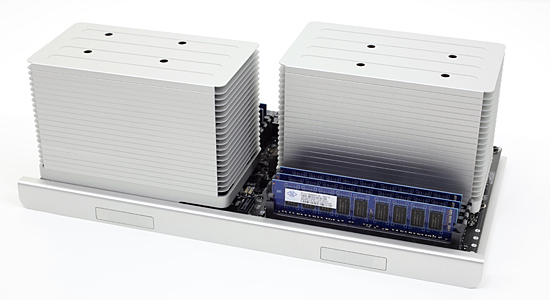
Two towering heatsinks, eight DIMM slots an X58 chipset are the main attractions. Remember all of the hoopla a few pages ago about Turbo Mode? That’s the reason for these beefy heatsinks; there’s actually a fan inside each heatsink, as well as two large fans moving air across the entire board in the case.

The heatsinks have an integrated fan and thermal sensor (black cable)
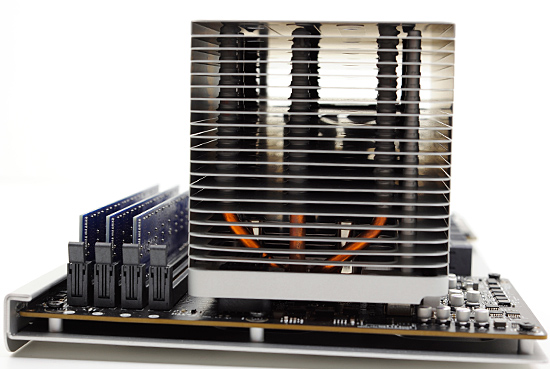
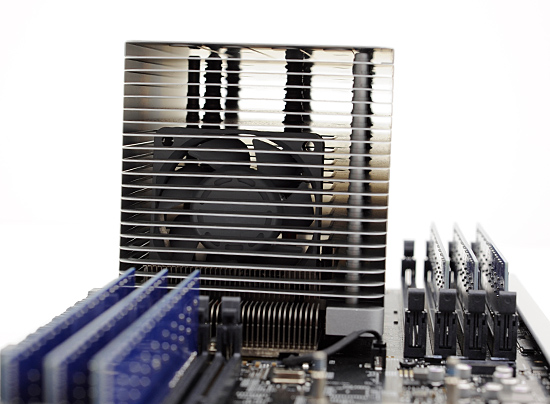
There are four screw holes at the top of the heatsink. Apple actually made removing the heatsinks very easy, all you need is a long 3mm hex key - about 3” long (plus a handle) should suffice.
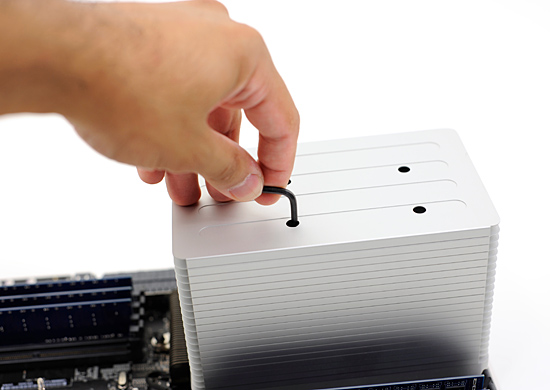
Stick the hex key in any one of the holes, move it around until it grabs, and then unscrew. Rinse and repeat. The screws are attached to the heatsink and spring loaded; you don’t have to physically remove any, just wait until they pop up.
With all four screws removed you can just lift the heatsink straight up. The CPU sockets don’t have clamps, so the chip will most likely lift out of the LGA socket attached to the heatsink.
Carefully twist and pull the CPU until it comes off of the heatsink and you’ll be greeted with the first surprise from Apple: the 8-core Mac Pro ships with lidless Nehalems.
Normally a Core i7 or Xeon processor will look like this:
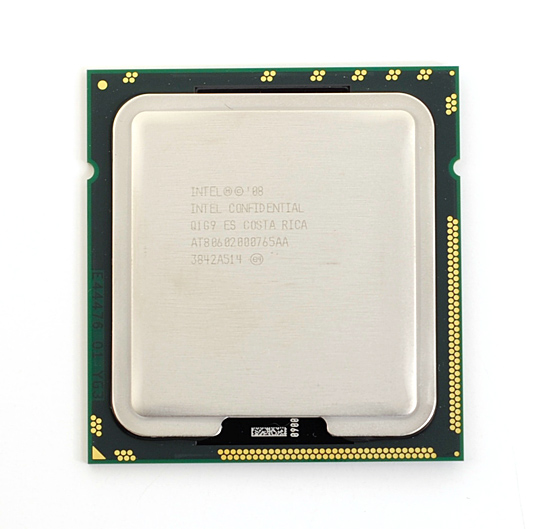
But the 8-core Mac Pro uses specially sourced parts from Intel that have no integrated heat spreader (IHS):

No lid, all Nehalem.
This is obviously a cooling play. The IHS is useful in preventing cracked cores from improperly installed heatsinks, but it does make cooling more difficult. With the heatsink flush against the bottom of the Nehalem die, it can remove heat faster from the chip. More efficient cooling results in lower CPU temperatures and lower fan speeds.
The lidless Nehalems are only used in the 8-core version as far as I can tell. The standard quad-core Nehalem Mac Pro uses regular Xeons with an integrated heat spreader.
The lidless Nehalems do provide a challenge: you can’t buy them. You have to buy a standard, lidded Nehalem Xeon and either remove the IHS or leave it intact and hope it works well. The first option isn’t a very good one; while removing a heat spreader isn’t impossible, you do run the risk of destroying your $1400 CPU. The second option, if it works, is the safest route.
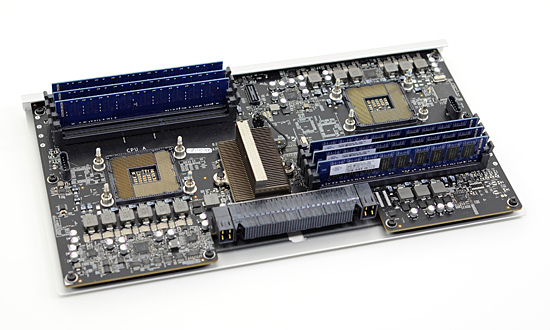
We got a pair of Xeon X5570s and tried to install them, with heat spreaders and all, in our 8-core Mac Pro. Simply pull one chip out, replace it, apply thermal grease, remount the heatsink and screw it back in...or so we thought.
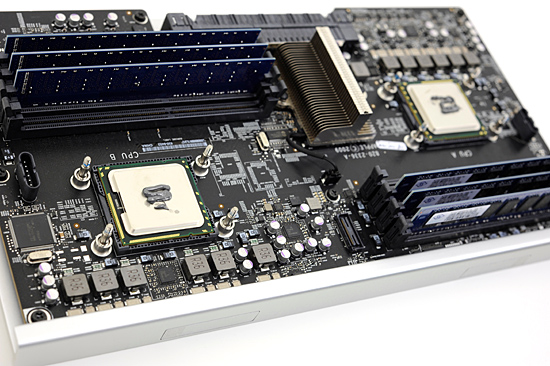
The lidless Nehalems were out, the new lidded processors should work - they should just be a bit more difficult to cool










58 Comments
View All Comments
mfago - Monday, July 13, 2009 - link
Apple lists the Mac Pro as supporting DDR3 1066 only, yet the higher speed CPUs should support 1333. Have you tested this? I have an application that would love faster memory.Secondly, while Apple's prices are much higher than previous models (due to Intel's CPU prices, as you note), have you compared similar machines from Dell/HP? _Significantly_ more expensive: a T5500 with 2x2.93 GHz and 12 GB ram is $8000 (before discounts). Otherwise, the only way to get decent prices is through second/third tier vendors, or building one yourself. Sure CPU/RAM upgrades have always been this way, but Intel's extreme prices on Nehalem make this very obvious.
austin512 - Saturday, May 1, 2010 - link
Hi Anand,Any word on if the W3680 will work in the 2009 Mac Pro?
rominator - Thursday, July 22, 2010 - link
"While you could stick Clovertown into the first generation Mac Pros, you couldn’t upgrade them to Harpertown without hardware modifications to the system (don’t ask me what they are :)..)."AFAIK, nobody has ever discussed being able to do this. ANyone have an idea what he's referring to?
mrob27 - Thursday, September 23, 2010 - link
Upgrading CPUs:I have the 2.26 GHz 8-core model. I cannot afford to take the risk, but I'd love to upgrade it someday if it was less risky.
I think you should carefully measure the thickness of Xeon processors with and without the heat spreader (using an outside micrometer or something), and add washers to compensate for the needed spacing where the screws mate the heatsink to the processor board. This would properly relieve strain from the CPU package and allow you to tighten the hex nuts to the proper (standard) tension. Based on your photos it looks like that should work.
Turbo mode:
I was able to get valid convincing single-threaded benchmark results (demonstrating Turbo mode in action) by using the "Processor.prefPane" from Apple's Developer Tools. This is a System Preferences module that is placed in /Developer/Extras/PreferencePanes when you install the Dev Tools, and you copy it into /Library/PreferencePanes to enable it. Then use System Preferences to access it. You can turn off hyperthreading and can selectively disable any combination of cores 2-8 (#1 is always on). See for example goo.gl/7MZm or goo.gl/OH4K
- Robert Munafo - mrob.com/pub/comp/mac-models.html
Auralwiz - Friday, July 13, 2012 - link
Did you ever try the 2.26 8 core CPU upgrade?I tired two w35675s and failed to boot. Is there two big of a speed increase limit?
Michael
Highjnx - Sunday, November 7, 2010 - link
I recently tried to upgrade the E5520 procs in my 2009 Octo Nehalem with a set of X5560 (2.8GHz). I was able to get the machine to power up with no error lights. However I didn't get a chime and it refused to boot.In reading Anand's article on upgrading with a set of X5570 chips I didn't see any mention of the X5560 as an option. Is there something written into the bios that prevents this from posting.
The other thing I question is the added height created by the Integrated Heat Spreader doesn't give a solid connection between the daughter board and the heat sink fan plug. Has anyone run across a how-to on removing the IHS?
Any insight would be appreciated as I have access to several set's of X5560.
todd-
Auralwiz - Friday, July 13, 2012 - link
I purchased two w3565 LG 1366 processors for my 8 core dual 2.26 GHz 2009 Mac Pro 4,1.These CPUs are 3.2 Ghz.
The install was easy but the machine would not boot up. I re-installed the two 2.26 original CPUs and the system returned to normal. Any idea why it didn't work on an 8 core system?
I had the same experience as user Highjinx.
Michael
Soren4 - Sunday, June 12, 2016 - link
As a 2009 Mac Pro owner, I've followed the upgrade discussions for these machines carefully for some time. There appears to be a lot of discussion and instruction on how to swap out processors but usually involving lidded CPU's instead, which pose potential risks of damaging the motherboard in the process.I found an interesting video tutorial on Youtube today that clearly explains, while demonstrating, how to effectively remove the soldered IHS off the CPU, with the cleaning off of the solder, without damaging it.
It seems to me that this would be a lot easier to do than having to modify the heat sync pads and add washers etc., all the while allowing the processors to stay cooler due to the removal of the IHS.
Here is the link for review.
https://www.youtube.com/watch?v=aPhDfUkll-o
Thanks